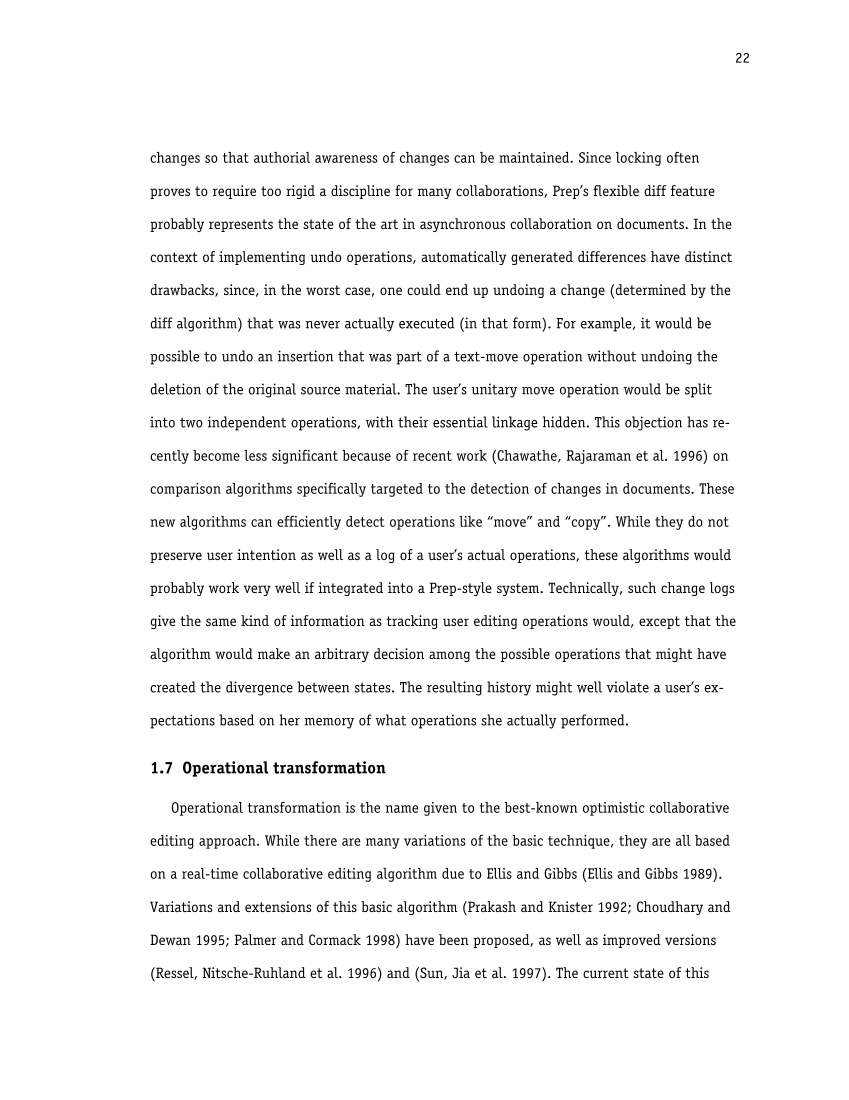21
The�problem�with�undo�in�group�work�is�that�many�of�the�simplifying�assumptions�possi-
ble�in�a�single-user�editor�are�simply�unreasonable�in�a�multi-user�situation.�For�instance,
one�thing�that�requires�modification�is�the�notion�that�a�user’s�changes�can�be�undone�in
the�reverse�order�that�they�were�performed,�even�though�one�good�way�to�resolve�a�conflict
among�users�is�to�simply�undo�some�of�the�problematic�changes.�The�linear�undo�model�fails
because�a�user’s�own�changes�may�have�been�followed�by�changes�made�by�other�users,�so
that�undoing�one’s�own�changes�is�impossible�without�also�undoing�those�made�by�another
user,�even�if�they�occur�in�another�part�of�the�object�being�edited.�The�same�situation�can
occur�any�time�a�user�attempts�to�undo�any�change,�in�fact,�since�the�order�of�user�notifica-
tion�of�changes�not�infrequently�varies�from�editing�instance�to�editing�instance.
As�in�a�number�of�other�areas�of�collaborative�editing,�synchronous�and�asynchronous
editing�have�been�handled�differently,�and�most�systems�have�concentrated�on�one�or�the
other.�The�synchronous�case�has�received�the�most�attention,�as�undo�is�one�of�the�problems
that�crops�up�immediately�once�simultaneous�editing�is�enabled.�One�approach�is�to�rewind�a
historical�log�of�changes�and�then�replay�them,�without�the�change�to�be�undone,�and�then
broadcast�a�change�cancellation�to�the�other�instances�of�the�editor.�This�approach�is�taken
in�(Prakash�and�Knister�1992;�Choudhary�and�Dewan�1995).�These�systems�extend�opera-
tional�transformation�to�support�this,�by�using�it�to�transform�operations�before�redoing
them.�Local�editors�must�retain�enough�history�to�backtrack�and�undo�specific�operations.
This�technique�does�not�work�so�well�if�off-line�as�well�as�on-line�collaboration�is�supported
by�the�system,�since�the�number�of�changes�involved�can�be�quite�large,�even�for�a�relatively
short�editing�period.
In�fact,�algorithmic�solutions�have�been�rather�sparingly�applied�to�this�problem�in�the
asynchronous�case,�exactly�because�the�typical�divergence�between�separate�long-term
transactions�is�large.�The�focus�has�generally�been�on�preventing�conflicts�by�means�of
locking�or�versioning�(as�in�the�software-engineering�domain)�or�on�the�detection�of
The�problem�with�undo�in�group�work�is�that�many�of�the�simplifying�assumptions�possi-
ble�in�a�single-user�editor�are�simply�unreasonable�in�a�multi-user�situation.�For�instance,
one�thing�that�requires�modification�is�the�notion�that�a�user’s�changes�can�be�undone�in
the�reverse�order�that�they�were�performed,�even�though�one�good�way�to�resolve�a�conflict
among�users�is�to�simply�undo�some�of�the�problematic�changes.�The�linear�undo�model�fails
because�a�user’s�own�changes�may�have�been�followed�by�changes�made�by�other�users,�so
that�undoing�one’s�own�changes�is�impossible�without�also�undoing�those�made�by�another
user,�even�if�they�occur�in�another�part�of�the�object�being�edited.�The�same�situation�can
occur�any�time�a�user�attempts�to�undo�any�change,�in�fact,�since�the�order�of�user�notifica-
tion�of�changes�not�infrequently�varies�from�editing�instance�to�editing�instance.
As�in�a�number�of�other�areas�of�collaborative�editing,�synchronous�and�asynchronous
editing�have�been�handled�differently,�and�most�systems�have�concentrated�on�one�or�the
other.�The�synchronous�case�has�received�the�most�attention,�as�undo�is�one�of�the�problems
that�crops�up�immediately�once�simultaneous�editing�is�enabled.�One�approach�is�to�rewind�a
historical�log�of�changes�and�then�replay�them,�without�the�change�to�be�undone,�and�then
broadcast�a�change�cancellation�to�the�other�instances�of�the�editor.�This�approach�is�taken
in�(Prakash�and�Knister�1992;�Choudhary�and�Dewan�1995).�These�systems�extend�opera-
tional�transformation�to�support�this,�by�using�it�to�transform�operations�before�redoing
them.�Local�editors�must�retain�enough�history�to�backtrack�and�undo�specific�operations.
This�technique�does�not�work�so�well�if�off-line�as�well�as�on-line�collaboration�is�supported
by�the�system,�since�the�number�of�changes�involved�can�be�quite�large,�even�for�a�relatively
short�editing�period.
In�fact,�algorithmic�solutions�have�been�rather�sparingly�applied�to�this�problem�in�the
asynchronous�case,�exactly�because�the�typical�divergence�between�separate�long-term
transactions�is�large.�The�focus�has�generally�been�on�preventing�conflicts�by�means�of
locking�or�versioning�(as�in�the�software-engineering�domain)�or�on�the�detection�of





























































































































































































